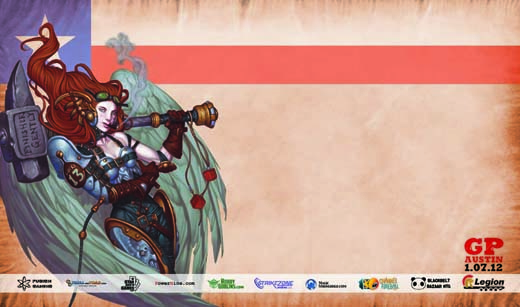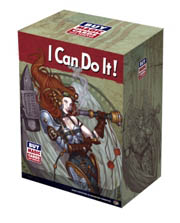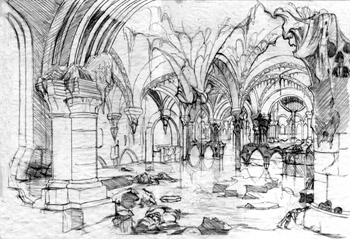I figure the second part to my first entry back in May is due. Fine, it's overdue. This week, do everything on my list, and you should be good to go. Well, you don't get a Jeremy Jarvis–approved Community Chest pass for a commission, but you'll be well on your way.
If you know an aspiring Magic artist, you guys, have that person read this article.
Buy a Wacom Tablet
If you wish to be a Magic artist, digital is simply the way to go. It’s not taking a shortcut to creating brilliance. No, if you have to make a correction to an oil painting, you won’t often have the time to make a change to your preferred level of quality. I think that if you have mastery in oils, your digital work will only benefit, but I come from a museum background. I feel that if you know a variety of media, your overall skill will improve.
Using a tablet will speed up your work. You don’t have to wait for paint to dry, take time to mix and blend paints, or figure out how to save paint on a palate. (You put it in the freezer. If you have a question about it, Randy Gallegos is playing with it to figure out the optimal temperature. Ask him. He’s friendly.)
Buy Adobe Photoshop
Yes, you do have to buy it. Pirating is unprofessional.
If you were smart, you would have purchased the full version when you were in art school and you’d just have to pay for an upgrade. Also, Wacom tablets have educational discounts. Use those discounts.
Oh, you didn’t go to art school? A pro tip for you: Do some freelance with a nonprofit organization, and then pay them for a full license. You’re a contracted employee, so you can receive the non-profit rate. It’s often a similar discount, if not the same, as the educational rate. If you’re not polished enough to do freelance work for a nonprofit, see if there’s an artist collective in your community or in a city near you. They love meeting new people, and a bonus is that you now have contemporaries to learn from.
Read More from Experts
What should you read? You should already be reading Art Order.
What you should add to your reading list:
- Muddy Colors – Nine artists and Arnie Fenner, the Spectrum guy, all post here. Useful.
- Irene Gallo’s Blog – Irene is among the top five art directors in fantasy art. Read it.
Read Magic Artist Blogs
I read them all religiously. These artists don’t post every day, but when they do, it’s very informative. If you only have time for one, read Matt Stewart’s blog–it’s amazing.
Here’re a few artists whose blogs I read on a regular basis. (There are a ton more.)
- Steven Belledin – Magic Art, Blog
- Daarken – Magic Art, Blog
- Bob Eggleton – Magic Art, Blog
- Ryan Pancoast – Magic Art, Blog
- Steve Prescott – Magic Art, Blog
- Chris Rahn – Magic Art, Blog
- Omar Rayyan – Magic Art, Blog
- Ron Spears – Magic Art, Blog
- Matt Stewart – Magic Art, Blog
Get on the Twitters
You might think it’s a soapbox for yelling opinions. There is that, but what I find really useful is when Magic artists discuss best practices or post artworks with commentary. You shouldn’t be constantly pestering experts for information or questions, but you can join the conversation. I have an ever-growing list here.
It’s also interesting when artists talk about the business side of art. It’s unsavory to discuss it, but it occasionally happens.
Contact Tournament Organizers to Be on Promotional Items
Minnesota’s local tournament organizer, Legion Games, recently commissioned RK Post to make an angel.
 |
 |
These artworks are noticed by oodles of people. Find the nearest Grand Prix tournament and contact the tournament organizer. Here’s the list of the next Grand Prix locations. Ahem—Minneapolis in May—ahem. Touching more points of a brand is always a wise idea.
Find Art Descriptions of Magic Cards
DailyMTG.com’s Arcana has a few art descriptions with sketches. Look to see how an artist came to the conclusions he or she did from just a few words. If that isn’t enough, find a piece in a Magic set that matches the aesthetic that is your art. Ask Jeremy Jarvis for that art description if he has it. Be prepared for a long wait, and in the interim, find similar examples with other companies.
This will build a relationship—a touch point for contact—and it will show a little nuance in the illustration.
Buy a Sketch and Print of a Magic Artwork
Many Magic artists sketch the image in pencil or ink before digitizing it. This sketch is scanned and sent to art directors for feedback. An artist then finishes the artwork in Adobe Photoshop.
 |
 |
Seeing a before-and-after for a major piece will give insight into how the artist made the work. I would try to find a Spectrum-winning artwork, as those pieces tend to be the highest quality artworks in a particular year. (Spectrum 18 is now available . . . ahem.)
You can often purchase these sketches for under $100. If you feel like negotiating, ask an artist if you can buy a final print with the sketch for $100. Digital artists don't have paintings that fetch $100 to $2000. Every extra $100 from a commission pays the bills.
Read, and Actually Do, More Tutorials
If you can’t correctly create a hand or foot, you need to start studying up. If you hide feet behind brushes and fallen soldiers, you know what I’m talking about. If you have a deficiency, you simply won’t make it.

My at-the-moment favorites for learning the basics correctly are made by Cedarseed. (And here are the tutorials.)
I’d buy the ninety-nine page book, but if you’re a starving artist eating ramen and peanut butter sandwiches, you can read the PDFs for now.
There are also Magic artist speed runs, like Aleksi Briclot’s Chandra’s Phoenix, which you can Google or find on YouTube. Take advantage of this free lesson.
Enroll in the Illustration Master Class
Consider this class to be two years of art instruction jam-packed into a week. It’s intense, but the instruction and one-on-one time will allow you to gain a grasp on being objective about your artworks, and hundreds of aspects of your artwork will improve. You’ll also meet contemporaries who have similar goals to yours.
Still not sure what it is? Check here and here.
Yes, it is expensive, but if you’re on the verge of getting a commission from a major gaming company, go here and you’ll get there.
Post Artworks on the Art & Artist Board on the Magic Community Page
Getting your art critiqued is vital to aligning it to a major brand like Magic. I’m on there all the time, and I know that Jeremy Jarvis reads the board. You will be noticed there.
I will admit that you have to be very clear about your intention if you post any art online. You will receive critiques whether you like it or not. This can be helpful—the fan boys know the intricacies more than you thought possible. They can also be cantankerous. Which leads us to . . .
Be a Pleasant Individual
If someone critiques your art and you become defensive, you won’t get very far. Keep in mind that you can bring one piece to four art directors and each will offer you different feedback. Each will look through the lens of his or her brand and give applicable feedback. You have to build a thick skin and own up to mistakes, oversights, and depictions that simply don’t fit a brand. But if you can’t draw a foot, everyone will tell you. Be ready.
This goes for online communication, too. The community is very small.

One final recommendation: Know the brand you’re pitching.
Bob Ross doesn’t paint spaceships.
And he definitely doesn’t paint ones that can do the Kessel Run in under twelve parsecs.
I wish you luck.























